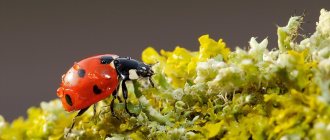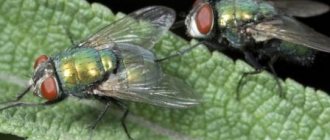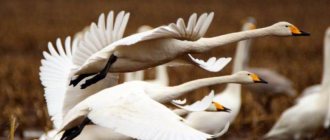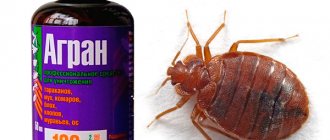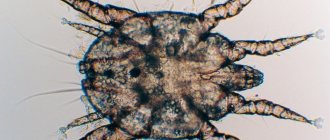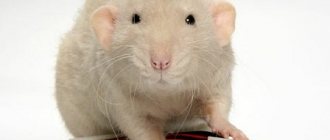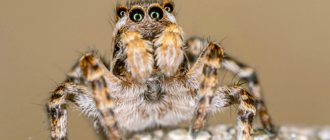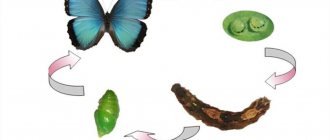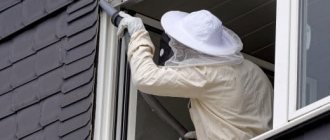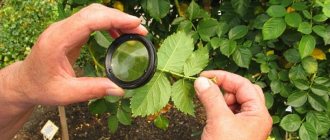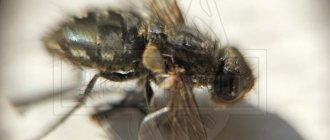The destruction of any parasite is effective only if their offspring are neutralized. The same is true with wasps. If you ignored this stage of the fight against the parasite, the colony will very quickly recover and again conquer your territory. If you find a nest with larvae, you need to start destroying them.
What do wasp larvae look like?
Aggressive pests go through a certain stage of transformation during their life. First, the female lays a larva, which develops very quickly and gradually transforms into a “pupa.”
Next, all organs are formed, the digestive system changes completely. After some time, an adult, viable individual flies out of the honeycomb. It’s interesting, but during the period of its growth the larva is not able to eat the food that wasps are accustomed to.
“Parents” obtain exclusively organic food for them: spiders, flies, cockroaches, and other insects. To make food suitable, the wasp paralyzes the prey and brings larvae to the honeycomb. The offspring slowly eats the victim.
The larva is practically motionless and can only rotate its head. The “pupa” of the paper wasp differs little from the offspring of other species of these pests. The difference may only be in the size of the larvae. In earthen parasites, the body has a rounded shape; individual segments can be clearly seen on it.
The wasp larva does not look at all like an adult; it does not yet have membranous wings or large paws. The new generation is not able to move at all, which is why they develop inside the honeycomb and do not leave it until the body is fully formed. Due to the reduced legs at the development stage, the larva can crawl a little, but only by wriggling strongly, resembling an ordinary caterpillar.
wasp larval development stages
The head of the larva is very small, almost invisible, but the jaws are well developed and are capable of chewing food.
The larvae are light in color: from whitish to yellow.
The complete transformation of the wasp's offspring occurs in the honeycomb. First, the wasps lay their larvae on the walls, practically blocking the entrance to the shelter with special glue so that the offspring do not fall out. As soon as the larvae begin active growth, their body increases sharply and they can no longer fall out of a kind of hole. Only the head of the future insect peeks out.
How to find and distinguish larvae
It is necessary to understand that it is unacceptable to destroy the home of aggressive insects in order to determine the location of their offspring. Despite this, knowledge of their external features and where the parent usually lays eggs can help eradicate the population.
Wasp larvae: stages of development, photo
External features
The young individual has the standard larval shape and also grows very quickly. In a short period of time, its size increases several times. Such larvae, regardless of the type of wasp, have several distinctive features:
- The body is extremely thick with a noticeable division into segments. Larvae preparing to move on to the next stage of adulthood may be larger than adults. This is justified by the fact that the insect needs to be kept inside the honeycomb. Due to its size, the wasp larva literally gets stuck in the passage. In this case, the insect's head is outside. Newborns are attached by their parents to the walls, followed by blocking the exit.
- Color ranges from white to yellow. Color largely depends on the type of wasp, but nutrition also has an effect. The larvae lack any protective coloring features. This is caused by the initial presence of shelter: the nest or the body of the prey.
- The head is almost invisible. The size of the head segment is minimal. Because of this, it is difficult to see it behind the thick body of the insect. But the larva has large jaws, allowing it to chew fairly soft food.
The limbs of the larvae are poorly developed, so they can only move by twisting (similar to caterpillars). The offspring of many wasp species are not able to move at all. All larvae can actively move their heads, which makes feeding easier.
Location of wasp eggs
The choice of laying site depends on the development of the maternal instinct. The latter, in turn, may vary depending on the type of wasp. Social wasps live in groups (including many of the most common species). In such insects, the larvae live exclusively in honeycombs, where the parents bring paralyzed prey. Most often, the offspring of social varieties are located in the following areas of the nest:
- from that part of the dwelling where it is attached to the wall;
- in the deepest tunnels (refers to underground nests);
- in a separate room, which is located a short distance from the main home.
Wasp larvae in a nest, photo
For this reason, many of the common methods of wasp control, such as smoking and treating with boiling water, are not always effective. Detecting the clutch of a single wasp is even more difficult, since this insect has many more options. Most often, such wasps create holes in the ground, where they leave unborn offspring along with paralyzed prey. The insect also closes the exit to ensure the safety of the young. Subsequently, the parent may either bring food to the larvae or not return at all.
Separately, it is necessary to isolate parasitic larvae. In this situation, the female lays eggs on the victim without paralyzing or killing her. Born wasp larvae quickly make their way inside their host, after which they eat it from the inside. At the same time, they try to avoid the organs that are most important to the prey, which allows them to feed on prey for a long time.
Interesting features of the OS
It is not only the clear hierarchy and distribution of responsibilities that make wasps insects of interest. There are many more unusual facts about them:
- wasps do not live at all in the Arctic, Sahara and the Arabian Peninsula;
- American scientists have found that paper wasps (the most common type) can recognize the faces of their relatives;
- due to the peculiarities of the anatomical structure, wasps can almost fold their body in half;
- Insects have five eyes: two large faceted ones on the sides of the head and three small ones on the forehead;
- wasps can not only sting, but also bite with their jaws;
- females of some species of solitary wasps sometimes build communal nests, where each has its own "room";
- wasps do not produce honey (with the exception of a few species);
- in total there are more than 17,000 species of these insects;
- wasps react to the smell of secreted poison and can join another individual during an attack.
In nature, these insects play a significant role, because they pollinate plants and are natural orderlies (destroying many other pests). For humans, wasps can pose a danger and threat. You can read more about this in the article Why wasps are dangerous.
What is the danger?
The wasp larvae themselves do not pose a threat to humans or animals. However, their presence significantly complicates the process of removing wasps from the site. Moreover, established insects that raise offspring become even more aggressive. This especially applies to protecting the territory and the nest in particular. In addition, the larvae support the life of the group in the following way:
- They occupy a separate place in the food chain. This is justified by the fact that adult individuals feed on nectar and juice of sweet fruits. The larvae cannot digest plant foods. However, they are very picky about food. The basis of their diet can be any insects, arachnids and molluscs that their parents can catch. That is, offspring and adults do not compete with each other.
- The larvae are able to feed individuals at the imago stage. The most amazing ability of young wasps is that their saliva contains enzymes that adults can feed on. Thanks to this, a group of wasps can survive long periods of unfavorable weather conditions or in the absence of the required amount of food.
- Having matured, the wasp larvae remain with the family. Thus, the insect most often joins the ranks of the group in which it grew up. Even if the offspring leaves their parents, there is a high probability that they will settle close to their old place of residence.
Getting rid of larvae is one of the main elements in the fight against dangerous insects. It is also important to know that the young of most wasp species develop very quickly, forming a pupa. In just 2 weeks, a larva can molt about 5 times. The pupa also most often grows within 10-18 days.
Reproduction and lifespan
Mating of the wasp nest queen, which occurs in the autumn, occurs sometime in October. The male individuals of these insects are usually called drones, just like bees. The purpose of such a colony caste is to copulate with the queen.
They have no other responsibilities. In the fall, the queen has contact with several drones at once, and when she receives their seed, she stores it in her body until the next spring. The males, having fulfilled their natural purpose, soon die. And the uterus falls into suspended animation for the entire period of severe cold and cold.
With the arrival of warmth, she, waking up from hibernation, immediately begins the work of building a nest. What material is used to construct the home of an aspen family has already been described; it should only be added that, like bees, it consists of cells.
Queen mating occurs with several male drones
First, the queen looks for a suitable place for the nest, and then builds honeycombs. And this entire structure ultimately ends up suspended on a branch or in a hollow tree or, as often happens, on the ceiling or attic of some building. A wasp nest can be found attached to window frames, in gardens and forests, and in abandoned burrows of small rodents.
An egg is laid in each cell and develops over the next six days. Soon larvae appear in the honeycombs. First, the queen, and at a later time other family members, take care of their feeding. Their food comes from insects, thoroughly crushed by chewing.
As time passes, the next stage begins - the pupa. The larva turns into it, wrapping itself in a web. This is called a cocoon. After 3 days, the imago hatches from it, that is, the wasp in the adult stage.
Wasp emergence process
It should be noted that the eggs of these insects are not all the same. They may or may not be fertilized. The eggs of the first type produce a new queen and worker wasps. Here everything depends solely on the type of nutrition in the larval stage. Drones are given life by unfertilized eggs.
After the worker wasps emerge from their cocoons, the queen’s mission to build a nest and feed her offspring ends; now her only concern is new eggs, which she lays three hundred a day.
wasp insects take over the responsibilities of feeding the larvae . They build honeycombs and feed the queen herself. By the end of summer, worker wasps stop hatching; in the autumn, only females and drones are born.
In some cases, the queen may lay her eggs in the fall. The resulting new generation of wasps goes in search of a pair to mate outside of their native nest. After completing the mission, the males, as usual, die. However, such a fate does not befall females. They hibernate in order to form their own new colony in the spring.
The queen lives the longest in the aspen family. Its lifespan is about 10 months. Worker wasps, like drones, live much shorter lives - about four weeks.
Wasp larvae: control methods
Unfortunately, folk remedies for getting rid of wasps are almost ineffective against their larvae. The smell of burnt pine needles and boiling water do not reach the part of the nest where the offspring are located. Therefore, to destroy the larvae, chemicals or methods of completely destroying the nest are most often used:
- Special aerosols and sprays. Particularly effective in confined spaces. They are extremely easy to use, but can pose a threat to humans. Before using this product, it is recommended to ensure that there is no allergic reaction. It is also unacceptable to remain in the treated area, as the contents of the spray may enter the lungs.
- Insecticidal dust. It is used to treat the home of insects. Unlike sprays, this method of control is safer. Although the effectiveness of dust is lower, it also successfully kills wasp larvae. Adults transfer the deadly substance to their offspring during feeding.
- Polyurethane foam. All the cracks in the nest are closed, after which it can be taken away. In this case, it is necessary to be careful, because the wasps may well end up next to the nest and begin to defend it. On the other hand, this method is completely safe for people and animals.
In addition, wasps and their larvae quickly die from kerosene. An acceptable method is to cover the nest with a bag and then burn it. But it is important to understand that when using these options there are quite large risks. Unpleasant odors can be used to get rid of adults. For example, citrus peels or burnt pine needles are often used. However, the larvae cannot leave the nest. Most likely, they will leave after the transition to the adult stage, but the population will not completely disappear.
Appearance
The size of the insect ranges from a millimeter to several centimeters, their color is also very diverse: there are black, brown, red, striped wasps, etc.
The photo clearly shows what this insect looks like and its characteristic features: a huge ovipositor, sometimes exceeding the length of the body, an elongated abdomen, well-developed wings and long antennae.
Appearance of an insect
Where do insects live
Species of social representatives build nests and form a hive. They set up a place of residence in an area where there is building material and food. Abandoned nests, rodent burrows, and anthills are often favorable places. As well as ordinary grass, dense tree crowns, thickets of bushes, stones, mounds of soil. They can settle on the territory of human possessions - garden, vegetable garden, outbuildings, roof, attic, balcony. The wasps spend the entire summer in the hive and leave the nest with the onset of cold weather. Only young fertilized females survive, finding shelter for wintering under the bark of trees and crevices.
Solitary representatives live in the wild, spending the night with their jaws and paws hooked on the grass. They climb into a flower. It is impossible to determine their exact location, since it is constantly changing.
Adult food
Adult wasps may appear to be omnivores. This is not entirely true, the wasp eats almost everything, but there are certain preferences. The most favorite food of adults is the juice and pulp of berries, fruits that ripen during the peak period of insect activity.
We can safely say that pests choose food. They prefer to leave the peel of the fruit, eating only the pulp. They especially like grapes, raspberries, plums, and blackberries.
Closer to autumn, pears and apples ripen, which they also do not refuse, but do not particularly like them. These fruits are rough and hard. If part of the crop has already fallen to the ground and has spoiled a little, they will eat them first.
Pests can be called sweet lovers. They happily eat honey, jam, and sugar. The most favorite delicacy is various syrups. They love kvass, beer, and various lemonades.
Scolia
These are the largest representatives of their species. Most of these wasps live in tropical and subtropical regions, but some move further north. The maximum concentration of insects was observed in Southeast Asia.
Large Scolia females reach sizes of up to 5 cm, with a wingspan of 10 cm. In a good half of the cases, the wasps are black in color with barely noticeable yellow or white spots. Adults act as pollinators.
The wasps themselves prefer nectar, and lay their offspring in the beetle colony. The victims are then paralyzed. Scolia larvae feed by eating both young and immobilized insects. Untouched foraging beetles, without realizing it, bring new food to the parasitic larvae.
It is possible to defeat parasites!
Antiparasitic Complex® - Reliable and safe removal of parasites in 21 days!
- The composition includes only natural ingredients;
- Does not cause side effects;
- Absolutely safe;
- Protects the liver, heart, lungs, stomach, skin from parasites;
- Removes waste products of parasites from the body.
- Effectively destroys most types of helminths in 21 days.
There is now a preferential program for free packaging. Read expert opinion.
Read further:
What do mosquitoes eat, besides blood, females and males, in the swamp and in nature?
Roundworms: size, color, nature of movements, shape of eggs and larvae
What do lice eat on the human body, the lifestyle of parasites
What is Streptococcus anginosus and what danger does it pose to adults and children?
How roundworm leads a parasitic life
Domestic insect parasites: photos and names, control methods
Do wasps eat meat and fish?
Very often you can see how the Hymenoptera circles over a plate with leftover meat, sits on it, and, having torn off a small portion, flies away. This manipulation is repeated many times. But entomologists explain whether wasps eat meat. In fact, the wasp does not feed on protein food, but only transports it to the younger generation.
This is an excellent nutritious protein food for the offspring lying in wait for the body . While the adult is on the way, she chews a piece of meat and feeds it to the babies. Hymenoptera are especially preoccupied with searching for protein food at the beginning of summer, when the young are growing up.
Fish and natural carrion are also of interest to sedges. This is a very convenient option, since there is no need to hunt, waste toxic substances and risk your life.
Varieties
- Megarissa pearly . A very rare species, is under state protection. Lives mainly in forests. The color is orange, with white and black stripes on the abdomen. The thin, hard ovipositor is twice as long as the abdomen and can even penetrate tree trunks.
Megarhyssa perlata
- Mutillids are represented by approximately 4 thousand varieties. The habitat is mainly steppe areas. Males, larger than females (their length is up to 3 cm), are dark brown or black in color, while females are orange or bright red with black splashes. The body is covered with thick long hairs. Females do not have wings, which is why they are called “velvet ants”. Unlike other species, they have a long sting, which they use to fight the owners of the nests, where they are going to lay eggs in their larvae.
Mutillidae
- Pompilid wasps , or road wasps, are found in almost all regions of the world, but are especially fond of hot climates. There are up to 4900 species. Their brown or black body is up to 4 cm long, and the females retract their ovipositor into the elongated narrow abdomen. The second name is explained by the fact that they make their burrows near roads. Females use large spiders to lay eggs.
Pompilidae or Psammocharidae
- Crabronids , or sand wasps, make their nests in the sand. Of the more than 8 thousand representatives of this species, approximately 600 are found in Europe. In appearance, thanks to the black and yellow stripes, as well as their small (up to 2 cm) size, they resemble simple wasps; they have the same well-formed wings and short antennae.
Crabronidae
- Scaephids are represented by 800 species, living mainly in warm climates. Their dark-colored body reaches up to 6 cm in length. They build nests in the sand or sculpt them on the walls of buildings. To lay eggs, the female finds a victim, paralyzes it and carries it to her nest.
Scefidae
- Betilids are represented by 1800 species, about a hundred of which are found in Europe. Their narrow body is 1-10 mm long, there are no wings, so they are sometimes mistaken for ants. Such agricultural pests as cotton moth and grape budworm become their victims and breeding ground for the larvae.
Bethylidae
- Scolia are quite large specimens for equestrians: their body length ranges from 2 to 10 cm, and their wingspan is up to 6 cm. Their habitat is mainly in the tropics, but sometimes they are also found in forest-steppe zones. The body of the scolius is black, with light stripes and spots on the abdomen; the wings are purple. Reproduction begins in May, and the female finds the larvae of cockchafers, weevils or rhinoceros beetles in the soil and lays eggs on them. Overwintering of the larvae occurs in the body of the victim, and pupation occurs in the spring.
Scoliidae
- The emerald cockroach wasp is found primarily in the tropics. The female uses a cockroach to lay eggs, before turning it into a real “zombie” with her bite. She drags a weak-willed cockroach by its mustache into a previously prepared hole, where it lays eggs in its body, and when the larvae hatch from the eggs, they feed on the living but paralyzed cockroach from the inside.
Ampulex compressa
- Trichogramma is a microscopic species, there are up to 200 species. The body is brown or black, dense, with antennae. Distributed on agricultural plantations.
Trichogramma evanescens
- The yellow wasp , 1.5-2 cm in size, lives in forest clearings and meadows. Most often found in summer and autumn.
Ophion luteus
How to get rid of insects from the garden
We associate wasps mainly with nests growing under roofs and windows. However, they can also appear even in the lawn, or rather in the ground. Below are several ways to get rid of earthen wasps on your property for a long time and effectively.
Drugs
A wasp nest built in the ground can be filled with boiling water or sprayed (the whole nest or the opening leading into the nest) with special anti-wasp contact preparations, for example:
- FicamSP (Ficam 80);
- Othos;
- K-Othrine Flow;
- Dichlorvos neo;
- Solfac (Solfac WP 10).
Spraying should be done when insects are inactive, for example, on a cool morning, before they fly out of their nests.
A wasp nest under the roof of a house, in the walls, in the attic, in the hollows of trees, can be smoked, for example, with insecticidal smoke bombs (“Nadzor”, “Quiet Evening”, etc.). The nest can also be treated together with its immediate environment with anti-insect sprays, for example:
- Baygon DP 1;
- Drone;
- Ficam (Ficam D).
Working insects flying into the nest will introduce a poisonous drug into it.
Contact insecticidal aerosols can be applied to surfaces on which insects gather - for example, Mosquitall, OtOs, Bros. Also, for the treatment of grape columns, under roofs, canopies, the preparations “Agita” and the “Great Warrior” gel are used.
Under no circumstances should these preparations be applied to bunches of grapes or fruits!
The drug "Agita" is also used as bait, mixing it with jam - 1 sachet per 0.5 liter of sweet jam.
Attention! It is not safe to spray yourself. You need to carefully prepare for chemical treatment. Dress, carefully covering your entire body, especially your hands, face, eyes, and neck. It is better to wear a protective suit with gloves and a veil on your head. The sleeves of the sweatshirt and pant legs should be pressed together around the wrists and ankles. Spraying is carried out late in the evening or early in the cool morning, when insects are least active.
Typically, pickling is carried out by specialized companies.
The worker insects carry the poisoned food into the nest several times and feed the poison to the queen, larvae, and other workers.
Ready traps
Worker wasps can be lured and destroyed. An effective method is to lay out traps with a luring substance. There are various types of traps available at gardening stores.
| Name | Photo |
| Solar-powered wasp trap (radius up to 30 meters) | |
| Trap Help | |
| Greengo |
A wasp trap is hung between the nest and the building that the insects visit. The trap should not be too close to the nest, then it will be less effective (working insects do not look for food directly at the nest - they fly away to a distance of several hundred meters).
How to make a trap yourself
When there are a lot of wasps and they are difficult to eradicate, it is worth knowing how to get rid of a hive with wasps on the site (by destroying adults and larvae) with poisoned baits. Summer residents practice hanging homemade wasp traps from plastic bottles. During fruit ripening, there should be the largest number of traps around particularly sweet crops. Practice shows that in this way it is possible to significantly limit the damage.
How to make a wasp trap from a bottle:
- We take a bottle of mineral water, cut off the top part with the neck.
- Then we turn the top over and place it back into the bottle. If gaps have formed at the junction between the plastic, they should be sealed with tape so that the trap is effective and insects do not escape from it.
- Pour a sweet drink (or beer) inside. Kvass and fermented compotes with the addition of insecticidal preparations are also used as bait for wasps. When pouring bait, you must make sure that the drink does not touch the neck of the bottle - as shown in the figure below.
- Also used for traps are baits (fish waste, minced meat, beef, poultry) mixed with a slow-acting poison, which includes imidacloprid.
This creates a trap into which the insect easily falls, but practically cannot escape.
Attention! Once the trap is full of insects, be sure to take extra care when emptying the bottle and check to see if the insects are dead.
Grids
To protect the harvest, you can use vegetable nets with small cells (up to 3 mm); summer residents sew special bags from gauze or tulle into which they place bunches of grapes. Similar bags can be found on sale.
Repellent odors
It is more difficult to fight wasps at home, where it is impossible to use potent chemicals and poisons that are toxic to people. If we want to get rid of wasps or bees without harming them, we should choose one of the proven repellent methods. We have chosen folk remedies for annoying wasps for the home, balcony, and cottage.
Fortunately, there are odors that wasps do not like:
- Vinegar. They especially don't like the smell of warm vinegar. You can place warm vinegar in metal bowls in the sun, away from your home, so there will be much fewer insects. You can treat garden furniture with vinegar solution.
- Clove oil . When a lot of insects arrive, in addition to vinegar, clove oil with a pleasant aroma for humans is a repeller.
- Lemon . When we sit in the garden, gazebo, or terrace, we can spread lemon zest around; its smell also repels insects.
- Tea tree oil can be applied to outdoor furniture.
- Herbs – basil, mint, marjoram, thyme, wormwood. You can plant them near the porch or gazebo. If wasps on the balcony are annoying, you can put several pots of basil and mint.
- Coffee , the smell of which insects do not like. You can use various coffee-scented candles or pour coffee beans into the bowl of an aroma lamp and place several candles under it that will effectively heat them.
- Some flowers will repel insects. These are pansies, lemon thyme, lemon balm, lavender, and some types of geranium.
- Garlic.
- Eucalyptus.
If the wasp's nest does not threaten or disturb people, you can leave it alone until late autumn. Then the swarm will die, the nest will be empty, and it can be safely removed.
Wooden walls of the house, wooden surfaces in the garden or on the balcony (gazebo, railings, platforms, stairs) should be painted with a special environmentally friendly impregnation that repels insects and prevents the creation of a nest.
How to get an insect out of your home
If a wasp or bee gets into the house, just wait until the insect lands on a table or wall, then carefully cover it with a glass. We carefully slide a hard sheet of paper under the glass and take the insect outside.
You can lightly spray the insect with water from a spray bottle to immobilize it for a while and take it outside.
How to prevent nest formation?
In the spring, you should inspect sheds, gazebos, attics of residential buildings, balconies, and other secluded places where it is dry and quiet and remove the beginnings of nests from them. All openings in buildings through which wasps can enter (including openable windows) should be protected with mesh with 3mm holes.
Wasps and hornets begin building nests in May. It is important to destroy wasps and hornets in time before they have time to create a colony!
Before wasps appear in the area of your home or dacha, you can protect yourself from them by hanging an artificial nest. These insects don't like competitors, so when they see a imitation nest, they won't set up one nearby. The finished product can be purchased in stores, or you can make a nest with your own hands. Just take a brown bag and put paper in it. The false nest should be hung where wasps most often try to settle.
What wasps don't like
Insects are sensitive to various pungent odors, so if you want to get rid of them, you can advise planting lemon balm and mint on the territory of your summer cottage, which can repel pests. The wasp definitely does not feed on such plants; moreover, it really does not like their smell.
Such fragrant plants include wormwood, basil, and geranium. Laundry or tar soap, which can be hung near the nest, repels pests. As surprising as this may sound, the smell of pine or pine smoke is also very unpleasant for insects; if it is detected, they may even leave their nest.
One of the least favorite foods for wasps is ordinary table vinegar and ammonia; insects cannot tolerate their aromas.
What do larvae eat?
The gastronomic preferences of wasps do not end with syrups, berries and other sweets. larvae are predators . Adults catch a wide variety of insects as food for their offspring.
The wasps chew the soft tissues of the prey, and the larva gets a protein gruel, which promotes rapid growth and weight gain. The adult individual itself licks the lymph from its victim, which contains all the nutritional elements it needs.
Another unusual food source for wasps is larval saliva. The latter secrete it in a decent amount after eating the victim (the process is tropholaxis). So the striped pests will not go hungry in any case.
What wasps live in the ground
It is believed that among the stinging black-and-yellow wasps, burrows in the ground are usually built by wasps of the genus Vespula, and beehives on the surface are hung by wasps of the genus Dolichovespula. Most often this is true, but there are exceptions to any rule in the case of wasps. Ground wasps can build a nest in any room or hang it on the wall of a building, and typically aerial species settle in cracks and cavities in buildings. That is, the location of the nest may indirectly indicate which genus its inhabitants belong to, but, on the other hand, you have no guarantee that this nest was not founded by a queen who decided to go against the traditions of her species.
Why are wild wasps dangerous?
Almost all wild wasps are capable of stinging quite painfully. At the same time, the strength of its bite and possible consequences for humans depend on the biology of the insect:
- for example, it would seem that large and terrible scolia sting relatively weakly and with virtually no serious consequences, since their venom is intended primarily to immobilize already inactive and harmless prey.
- But the venom of many species of hornets is so strong that it causes extensive swelling and very acute pain. Sometimes an allergic reaction to such a bite can lead to anaphylactic shock and death. Huge tropical hornets are especially dangerous in this regard - several simultaneous bites can cause internal bleeding.
It is also useful to read: What to do if a child is suddenly bitten by a wasp
Review
“We had a story with hornets at our dacha. They settled right in the toilet, and when, after our arrival in the summer, my husband and I decided to take them out, they attacked Seryozha in a swarm. He received 8 bites, it was impossible to look at him calmly. It felt like he was inflated like a balloon, his eyes couldn’t open and his nose couldn’t breathe. It’s good that the partnership has a first-aid post, where he was given an injection of anti-allergy medication. This was the only thing that probably saved me. We also had to constantly give him painkillers, because because of the bites he couldn’t sleep at all.”
Nadezhda, Moscow
Among the wasps there is also an insect with one of the most painful bites in the world: the road wasp Pepsis elegans, whose main prey is tarantulas, is considered the second most painful insect in the world after the South American bullet ant.
Hornets feeding
Large representatives of the wasp family are endowed with powerful jaws and a strong sting. Their diet is similar to that of paper wasps, but due to their large size, hornets are able to prey on larger insects, even animals. Adults eat fruit and vegetable juices, flower nectar, and honey. They often attack bee hives, eat honey reserves, and carry away the corpses of bees to the larvae.
On a note!
To provide food for the younger generation, hornets prey on smaller wasps, locusts, grasshoppers, spiders, amphibians, and rodents. Even birds can suffer from attacks by predators. Hornets are extremely aggressive and grouped. If one member of the family discovers a food source, in a moment there will be a whole swarm there.
The wasps themselves become victims of birds, sidewalk spiders, hedgehogs, bears, skunks, toads, rats, and mice. Bears and hedgehogs ruin wasp families, without fear of being bitten. The sting does not reach the skin, thanks to the spines and thick fur. The shrike impales wasps on wooden spines and then eats them. Flycatchers and wasps catch striped insects in flight, tearing off the abdomen with a sting.
